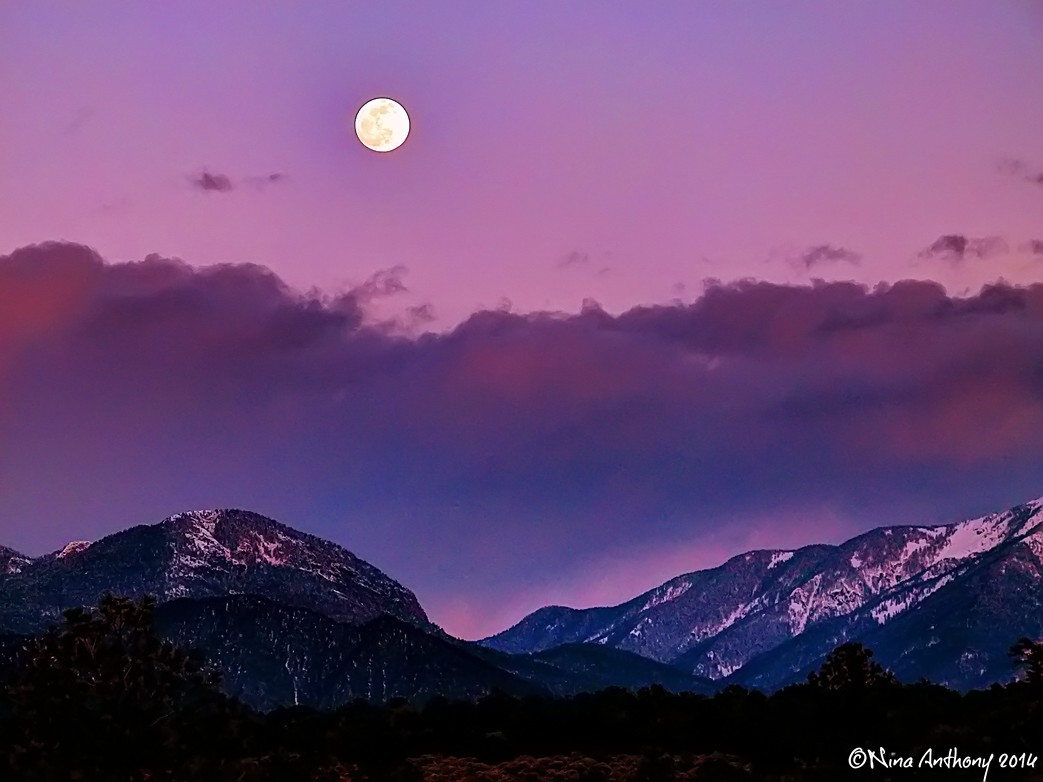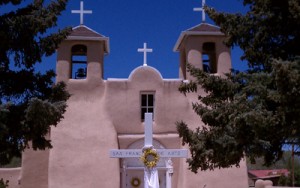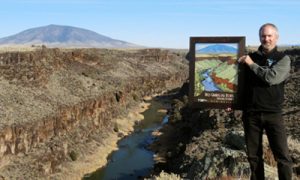By Nina Anthony, Saturday, July 19, 2014
I still recall the feeling of awe that I felt the first time I visited San Cristobal, home of the historic D.H. Lawrence Ranch in New Mexico. I remember thinking to myself, “Someday, I hope to live here.” That day came 14 years later when I moved to the quaint rural valley at the foot of the Sangre de Cristo Mountains.

Like many places in New Mexico, time seems to stand still in San Cristobal. The pace of life is slower, laid back. Residents meet occasionally at the tiny local post office to pick up mail and catch up on gossip; work side-by-side during the annual ditch cleaning to prepare the fields and orchards for irrigation; play bingo together and listen to traditional Spanish folk music during San Cristobal Feast Days at the end of the summer. For me and my husband, it was the utopian society that D.H. Lawrence envisioned when he moved to San Cristobal in 1924 -– a place to live more simply and escape the busy-ness of life.
From our front porch, I can look southeast to see the land where Lawrence and his wife Frieda lived in 1924. They had first visited Taos in 1922 at the invitation of Taos art patroness Mabel Dodge Luhan. Prior to settling in Taos in 1919, Mabel Dodge was a prominent figure in the arts and society circles of Greenwich Village and Europe, hosting salons with political and artistic luminaries of the early 20th century to discuss avant-garde ideas of the times.
In 1923, after divorcing her third husband, the artist Maurice Stern, Mabel married a Taos Pueblo man named Tony Luhan. Over the years, Mabel invited notables such as Georgia O’Keeffe, Alfred Stieglitz, Willa Cather, Marsden Hartley, Ansel Adams, Aldous Huxley and many others to her home in Taos in hopes of awakening a deep spiritual revitalization that would inspire the kind of ground-breaking work that would encourage other creative minds to visit Taos.
 Mabel viewed D.H. Lawrence as the ideal spokesman to help her spread the word about Taos — her utopian Western civilization. In March 1924, the British novelist, poet, playwright, essayist and literary critic and his wife Frieda, accompanied by their friend Dorothy Brett, an English painter and aristocrat, took Mabel up on a second invitation to visit Taos. On this visit, Mabel gave the Lawrences a 160-acre ranch she owned approximately 20 miles north of Taos. The ranch was known then as the Kiowa Ranch because Kiowa Indians had used a trail which ran through the property when they traveled south to raid Indian pueblos.
Mabel viewed D.H. Lawrence as the ideal spokesman to help her spread the word about Taos — her utopian Western civilization. In March 1924, the British novelist, poet, playwright, essayist and literary critic and his wife Frieda, accompanied by their friend Dorothy Brett, an English painter and aristocrat, took Mabel up on a second invitation to visit Taos. On this visit, Mabel gave the Lawrences a 160-acre ranch she owned approximately 20 miles north of Taos. The ranch was known then as the Kiowa Ranch because Kiowa Indians had used a trail which ran through the property when they traveled south to raid Indian pueblos.
D.H. Lawrence lived only five months at the ranch, but it was the only home he ever owned and he often wrote about its profound influence on his life after his departure.

“I have never experienced anything like New Mexico. As those mornings when I went with a hoe along the ditch to the canyon, at the ranch, and stood in fierce, proud silence of the Rockies, or their foothills, to look far over the desert to the blue mountains away in Arizona, blue as chalcedony, with the sagebrush desert sweeping gray-blue in between, dotted with tiny cube-crystals of houses: the vast amphitheater of lofty, indomitable desert, sweeping round to the ponderous Sangre de Cristo Mountains on the East, and coming up flush at the pine-dotted foothills of the Rockies! What splendor! Only the tawny eagle could really sail out into the splendor of it all.”
During his time in San Cristobal, Lawrence completed his short novel “St.Mawr,” which was inspired by his experiences and landscapes of Kiowa Ranch. He also wrote his biblical drama, “David” and parts of “The Plumed Serpent” during his last visit to the ranch over several months in 1925.
 After Lawrence returned to Europe and succumbed to tuberculosis in southern France in 1930, Frieda returned to the ranch to live with her lover-turned-husband, Angelo Ravagli. In 1934, Frieda sent Ravagli to Vence, France, where Lawrence had spent the last weeks of his life in a sanatorium, to have his body exhumed and cremated and his ashes brought back to the ranch to be housed in a small memorial shrine that Frieda had built on a hilltop overlooking the ranch.
After Lawrence returned to Europe and succumbed to tuberculosis in southern France in 1930, Frieda returned to the ranch to live with her lover-turned-husband, Angelo Ravagli. In 1934, Frieda sent Ravagli to Vence, France, where Lawrence had spent the last weeks of his life in a sanatorium, to have his body exhumed and cremated and his ashes brought back to the ranch to be housed in a small memorial shrine that Frieda had built on a hilltop overlooking the ranch.
There are a couple of different accounts of the actual whereabouts of Lawrence’s ashes, but the most widely accepted story is that Mabel Dodge Luhan and Dorothy Brett felt that Lawrence’s ashes should be spread throughout the ranch rather than be entombed in Frieda’s shrine. To ensure that she got her way, it’s said that Frieda dropped Lawrence’s ashes into a wheelbarrow full of wet cement that was destined to be used in the shrine’s altar.
In 1955, eight months prior to her death, Frieda gave the Kiowa Ranch to the University of New Mexico, on condition that the ranch be used for educational, cultural and recreational purposes and that the Lawrence memorial be open to the public. While it has been open to the public on and off through the years in accordance with Frieda’s wishes, for the past several years, the ranch, known today as the D.H. Lawrence Ranch, has been open to visitors on a limited invitation-only basis.
Thanks to a cooperative agreement between UNM, the D.H. Lawrence Ranch Alliance, and the Taos Community Foundation that has been years in the making, the D.H. Lawrence Ranch, is once again open for regular public access.
D.H. Lawrence Ranch New Visitor Hours
Monday, Thursday and Saturday
10 am – 4 pm, through October
 Trust me, if you haven’t been to the ranch, it’s a must-see site, whether you’re a Taos visitor or local. I have been there many times and can tell you that it’s difficult not to feel the presence of its famous past inhabitants. As you wander the grounds and soak up the scenery that inspired Lawrence; peer into the modest late 18th-century Homesteader’s Cabin where the Lawrences lived and see the towering Ponderosa pine tree under which Lawrence spent his mornings writing at a small table (the tree was immortalized in Georgia O’Keeffe’s 1929 painting entitled “The Lawrence Tree” ) you feel a connection to the author whether you’re a fan or not.
Trust me, if you haven’t been to the ranch, it’s a must-see site, whether you’re a Taos visitor or local. I have been there many times and can tell you that it’s difficult not to feel the presence of its famous past inhabitants. As you wander the grounds and soak up the scenery that inspired Lawrence; peer into the modest late 18th-century Homesteader’s Cabin where the Lawrences lived and see the towering Ponderosa pine tree under which Lawrence spent his mornings writing at a small table (the tree was immortalized in Georgia O’Keeffe’s 1929 painting entitled “The Lawrence Tree” ) you feel a connection to the author whether you’re a fan or not.
The magnetism of San Cristobal that exerted its pull on Lawrence has been attracting creative souls ever since.
Today, San Cristobal is home to a number of writers, poets, photographers, filmmakers, musicians, artists and free-thinkers. There are a handful of old timers in the area who remember Frieda. One was just a child when his mother worked as Frieda’s maid. Another longtime San Cristobal resident, 101-year-old Jenny Vincent, moved to the area in 1936 after accepting an invitation from Frieda Lawrence to visit the area. Vincent gave this photo to my husband before health forced her to leave San Cristobal a few years ago. It shows her enjoying a picnic at the ranch with Frieda and her husband Angelo. (They’re facing the camera on the right.)
The re-opening of the ranch is an achievement that took years of hard work and collaboration from many individuals. But there is still much work to be done to preserve to Lawrence’s legacy in New Mexico and the ranch’s historic buildings from deterioration. If you’d like to help support the ongoing efforts necessary to maintain and revitalize the ranch, please consider making a tax-deductible donation to the Taos Community Foundation. (Scroll down toward the bottom of the page to the Sponsored Projects section and click on the DH Lawrence Ranch Fund.)
Getting There:
From Taos, head north toward the traffic light that marks the intersection of Highway 150, Highway 64 and Highway 522. Continue straight through the light on Highway 522. Go to Milemarker 10 and look for the Historic Marker sign on the east side of the highway that’s covered with a steel plate. Turn right and go approximately 6 miles up the dirt road to the Ranch.




